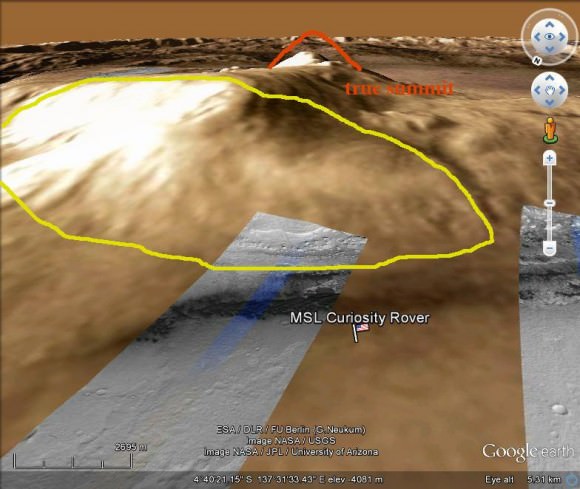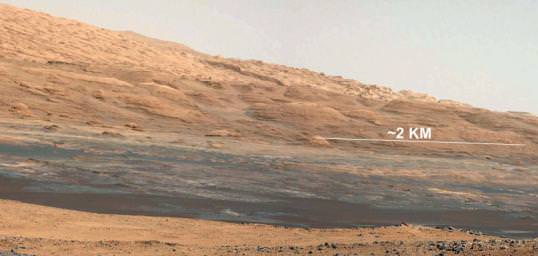The latest raw images downloaded from the Curiosity rover provides the first full view of Mt. Sharp (Aeolis Mons). Stuart Atkinson has stitched together images from the Navigation Camera to give us the first full look at Gale Crater’s central mound.
Another image wizard, Damien Bouic has created a truly spectacular view of Mt. Sharp, which includes parts of the rover itself and the blazing Sun. This image comes from forward Hazard Avoidance camera on the day of the landing. It’s a wide-angle, fisheye camera, according to Emily Lakdawalla, and while it is a low-resolution image, the “poster” Bouic created is truly stunning.
But as Stu points out on his new and wonderful blog “The Gale Gazette,” while we can now see the full northern face of the mountain, we’re not actually seeing all of Mt. Sharp nor the highest peak. “This isn’t the summit at all. Far from it,” Stu writes.
The actual summit is hidden by the highest point visible to Curiosity, and is just the ‘front’ of Mt Sharp as seen from Curiosity’s landing site.
See Stu’s image below for analysis:
Caption: Google Mars view of Curiosity’s landing site and Aeolis Mons. Annotations by Stuart Atkinson.
What this means is that Curiosity probably won’t ever really see the the highest point on Aeolis Mons… unless she’s a really great mountain climber and has a really long extended mission, making it to the highest point now visible from the landing site.
“I’m a bit worried that we won’t get to see that summit at all,” Stu wrote. “The closer we get to Mt. Sharp’s base, the more mountain will be between us and the summit. And once Curiosity reaches the foothills of the mountain, the viewing angle will just be completely wrong, the summit will be hidden by the rising terrain.”
There’s also a wonderful color image put out by JPL and Malin Space Science Systems yesterday:
Caption: Curiosity’s 34-millimeter Mast Camera acquired this high-resolution image on Aug. 8, 2012 PDT showing layered deposits. A scale bar indicates a distance of 2 kilometers (1.2 miles). Image Credit: NASA/JPL-Caltech/MSSS
This image is taken from a mosaic and shows the view from the landing site of NASA’s Curiosity rover toward the lower reaches of Mount Sharp, where Curiosity is likely to begin its ascent through hundreds of meters of layered deposits. The lower several hundred meters show evidence of bearing hydrated minerals, based on orbiter observations. The terrain Curiosity will explore is marked by hills, buttes, mesas and canyons on the scale of one-to-three story buildings, and as MSL’s John Grotzinger said yesterday at the Curiosity press conference, the view looks very much like the Four Corners region of the western United States.
JPL did do a little processing of this image however, and shows the colors modified as if the scene were transported to Earth and illuminated by terrestrial sunlight. This processing, called “white balancing,” is useful to scientists for recognizing and distinguishing rocks by color in more familiar lighting.
You can see more images from Curiosity at the JPL Photojournal, and also see the latest raw views here. The wonderful photo-magicians at UnmannedSpaceflight.com are having a marvelous time with all the new images from Curiosity, and you can always see what they’ve come up with — which includes multiple mosaics and color versions hot off the photons of the latest raw images from MSL. Emily Lakdawalla at the Planetary Blog is also working her imaging processing software to the max, so check out her latest posts, too!




Referring to Aeolis Mons as ‘Mt. Sharp’ is rather like continuing to call Pluto a planet, Ceres an asteroid and Andromeda (M-31) a nebula.
Absolutely agree! “Mt. Sharp (Aeolis Mons)” should read “Aeolis Mons (Mount Sharp). Mount Sharp or Aeolis Mons? From the horse’s mouth: “Mount Sharp is only an informal name,” says Guy Webster of NASA’s Jet Propulsion Laboratory”. After all, “the International Astronomical Union (IAU) selected ‘Aeolis Mons’ as the name for the mountain”. http://content.usatoday.com/communities/sciencefair/post/2012/08/mount-sharp-on-mars-at-odds-with-official-name/1#.UC8dCV_6csh
Slightly off topic: I wonder if shelter could be found in an “ex-“vent of Olympus Mons. I’m assuming that it is inactive. Just seal off as much as you want.
This ‘Itchy Monkey’ can’t wait to see more, more, MORE! Every image and video fascinates!
Als the news on universe today is about curiosity. It there really nothing else to talk about. I think that this mission is very interesting, but I see only news about
curiosity
Rover has one of the best cameras, why the images from Mars are still unclear?
Is there something distorting?